Nov 03rd
 I expected to need about 4 or 5 days to cycle the next 400 kilometers from Itaituba to Jacareacanga, and about the same time to memorize the name "Jacareacanga" :-)
I expected to need about 4 or 5 days to cycle the next 400 kilometers from Itaituba to Jacareacanga, and about the same time to memorize the name "Jacareacanga" :-)
The jeep driver I met yesterday told me it would be a very bad road, very hilly and with absolutely no supply, no houses except for a small village, so small that it doesn't even have it's own name. It's just called "Kilometro 180". The road is said to be full of snakes, spiders and jaguars and it would be absolutely impossible to make it by bike. He offered me a free ride, he would leave "tomorrow or the day after tomorrow", but of course I did not accept.
In spite of the discouraging reports about the road condition, I'm glad that I finally got the confirmation that the road exists at all. For 1500 km people told me that it is closed, abandoned and overgrown. My option would have been to take a banana boat from Itaituba down the Tapajˇs river to Santarem, then up the Amazon river to Manaus and via the Madeira river to Porto Velho, a journey that would take as long as I expect now for biking there...
I left the hotel only at 7:00. Usually I started at sunrise, that is, in this area, between 5 and 5:30, but today I still suffer from yesterdays party, and finally I still have to do some important shopping before leaving for the jungle: I need lots of spare screws, as I already lost several (on the bike!!), and I needed new break blocks. They were new when I started in Belem, but now I already reached the metal parts...
I don't need to buy any extra food. I still carry with me what I bought in Belem, so far I never activated my shiny new gasoline stove...
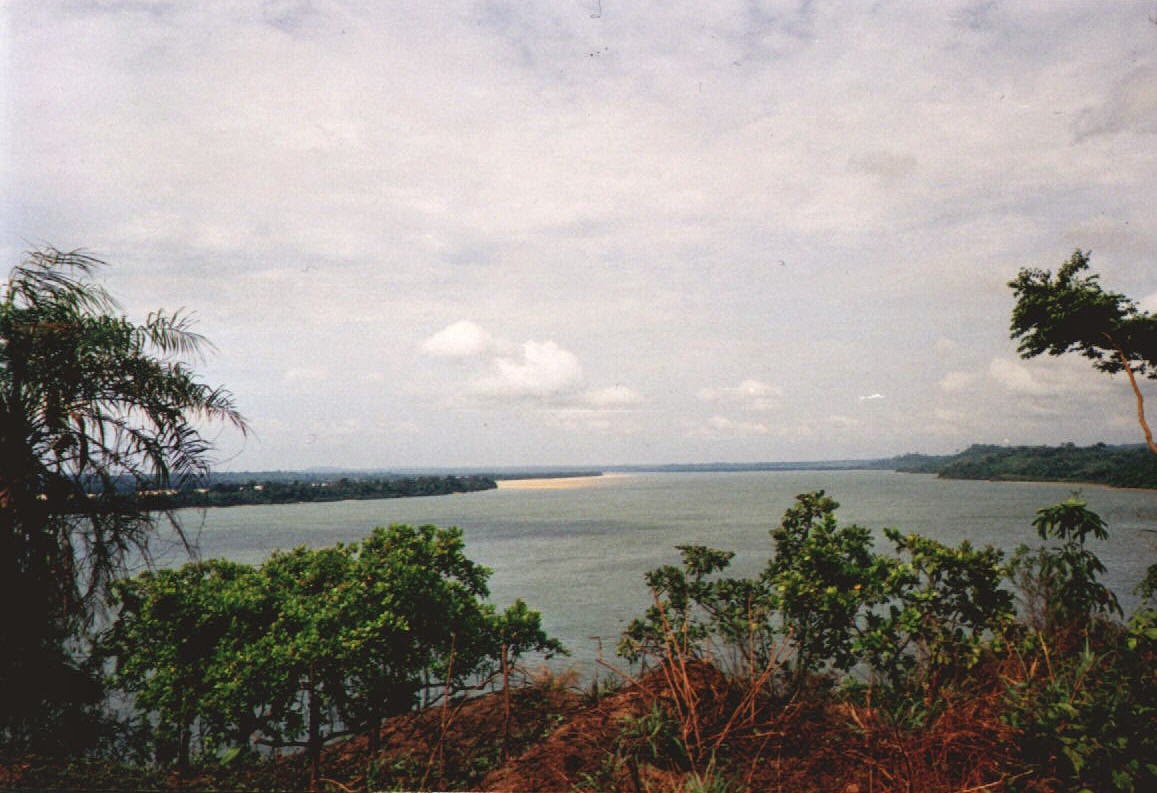
The road out of Itaituba starts with several kilometers of ugly washboard gravel, probably the worst surface after sand and mud... I just left the last "suburbs" of Itaituba when the front rack breaks down again. Good luck that I bought 10 spare screws... but this time it was not, as usual, the screw, it was the complete eyelet that broke down. I fix it with some old wires and after some test loops I decide not to return to town but to continue...
It was sunny again, and the road followed the Rio Tapajˇs for about two hours, giving some wonderful views of the blue river and the white sandbanks, surrounded by dense green jungle.
But then it left the river to parallel it several kilometers inland, where the hills are much higher... :-(

50 kilometers from Itaituba is the entrance to a place I looked forward for a long time with a mixture of fear and curiosity: The Amazonas National Park. That is 130 kilometers of pure native jungle, with no farms, no bars, no restaurants and no one to help in case of emergency.
There is an outpost of the IBAMA, the Brazilian Forest authority, at the park entrance, and that's where I meet, for the first time since I left Belem, another tourist. Marcus, a Brazilian from SŃo Paulo is sitting there on the roadside on top of his backpack, waiting for someone to give him a ride further into the park. He's going to spend a month alone in the jungle. I looked at him and thought "This man is crazy", and I knew he thought exactly the same about me that moment....
We discussed several travel issues, including how to defend of onša (jaguar) attacks. He had a long, sharp-ended bamboo stick to keep the beasts on distance while I trusted in my machete on top of my rear panniers, plus the protection I can find behind my bike. Both methods work only given the case that you notice the onša before it attacks, so we agreed that both weapons would be basically of psychological importance. I'm not a biologist, so I can't estimate the real risk of being attacked by a jaguar, but I think the risk is far overestimated. At least I never met someone who actually saw a jaguar in wildlife. Or is it because no one survived such a meeting??? ;-|
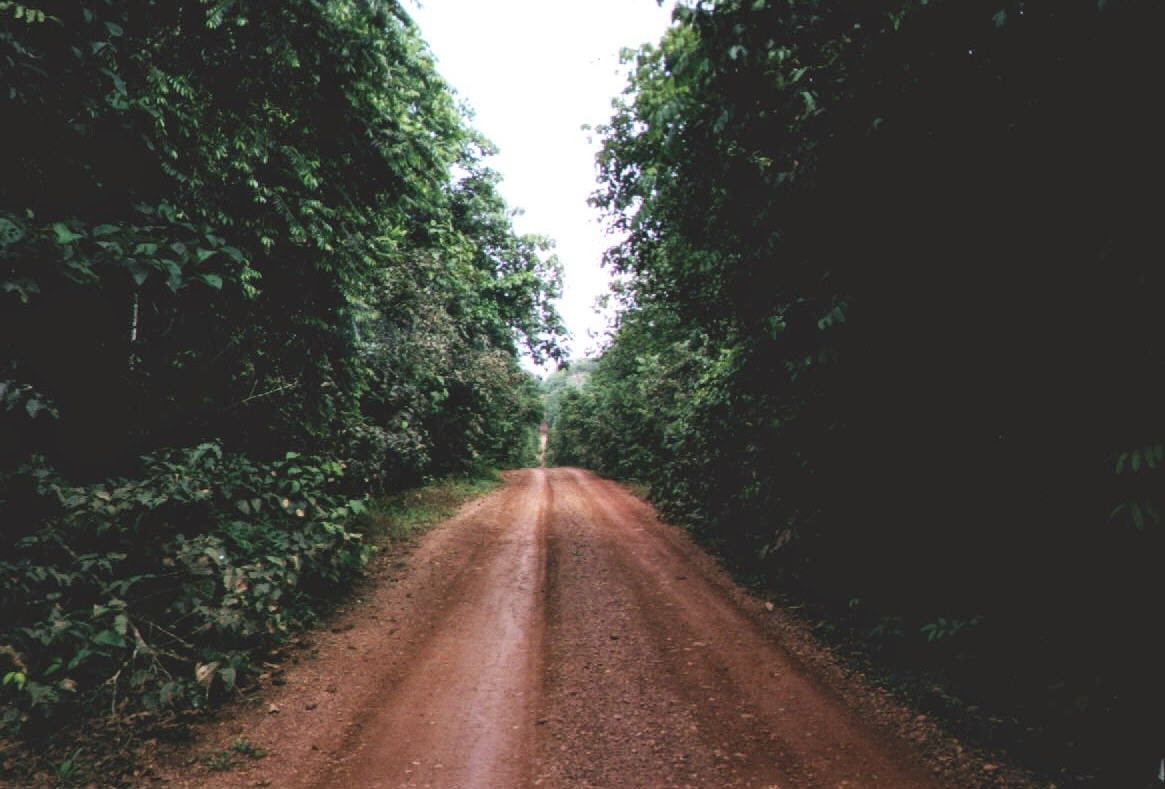
Inside the park the road narrowed to a 2,50 meter wide jeep track, trees and bushes came in from both sides. I climbed up and down over the hills, hundreds of butterflies flew around and for hours there was no sight of "civilization". I was alone with my bicycle.
Cycling is not easy. I had to cycle either on the right or on the left side of the track, where the surface was flattened out by the wheels of the cars, but that's where the thorny bushes grew in. So I had the chance to scratch either my right or my left side. I was also afraid of spiders, snakes, ants and other unpleasant lifeforms sitting in the bushes, so I often preferred to cycle in the bumpy middle.
Sometimes vegetation formed a kind of tunnel, which gave me some welcome shadow. For some reasons I didn't dare to jump into the waters here. The park is about the size of Yellowstone, and most of the land is still untouched. Who knows what's there upstream...
Not a single car passed by today, and in the afternoon I start to wonder if I'm still on the main road. The track looks like nothing more than an old logging road. Was there any junction where I took the wrong way??? Maybe it's just a track that leads to any farm, drug deposit or cocaine distillery..... According to my GPS I'm on the Transamaz˘nica, but still I have my doubts....
In the late afternoon I still haven't seen any houses or cars. Somewhere I have to fill my water bottles. I have only 20 minutes left before sunset, and unfortunately I can't find a clean river. So I have to pick up water from any pond. It's brown and muddy, with mosquito larvas swimming around....
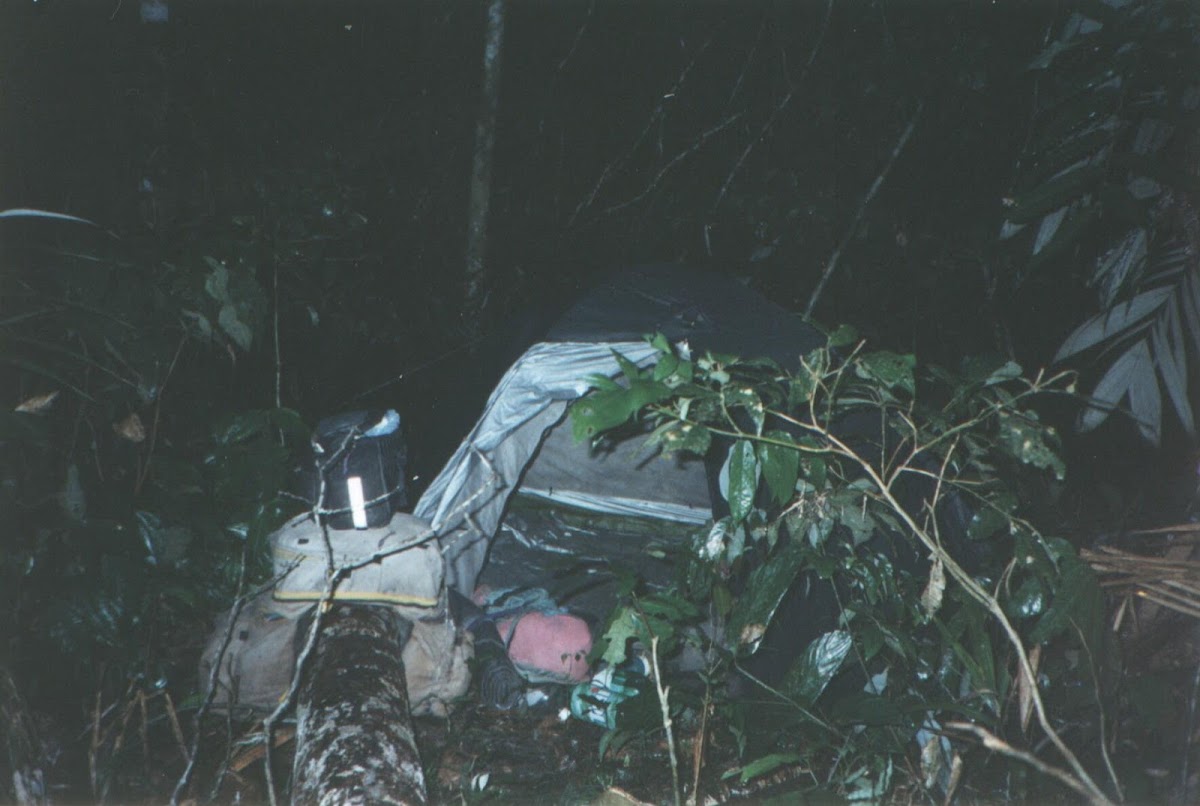
It takes me half an hour to clear out some space for my tent, and while working hard with my machete I start to wonder why I haven't just set it up on the road... Then I need to boil my water supply for tonight and tomorrow. It's the first time I use my stove. It's hot in the tent, and the heat of the stove outside adds some extra degrees. I guess that I sweat out half a liter while boiling one.
I try to filter out leafs, wood and other debris and boil it for a long time to disintegrate the mosquito larvas, but still the water remains dirty and muddy. It was OK for the tea, but it added a strange taste to the risotto...
Nov 04th
As usual I could hear a lot of noises at night and I hoped none of them was caused by a jaguar... At 4 in the morning the birds and apes start their concert.

I leave early. I share the road with hundreds of animals, either those that start their day now or those going back "home" to sleep. Later the day the snakes and spiders come out, I can see species of every size and color, what doesn't help me much to enjoy cycling close to the bushes...
I try to take some pictures, but by the time I prepared my camera they all disappeared. The only animal I manage to photograph is a turtle, crossing from the right, so I had to give the right of way...
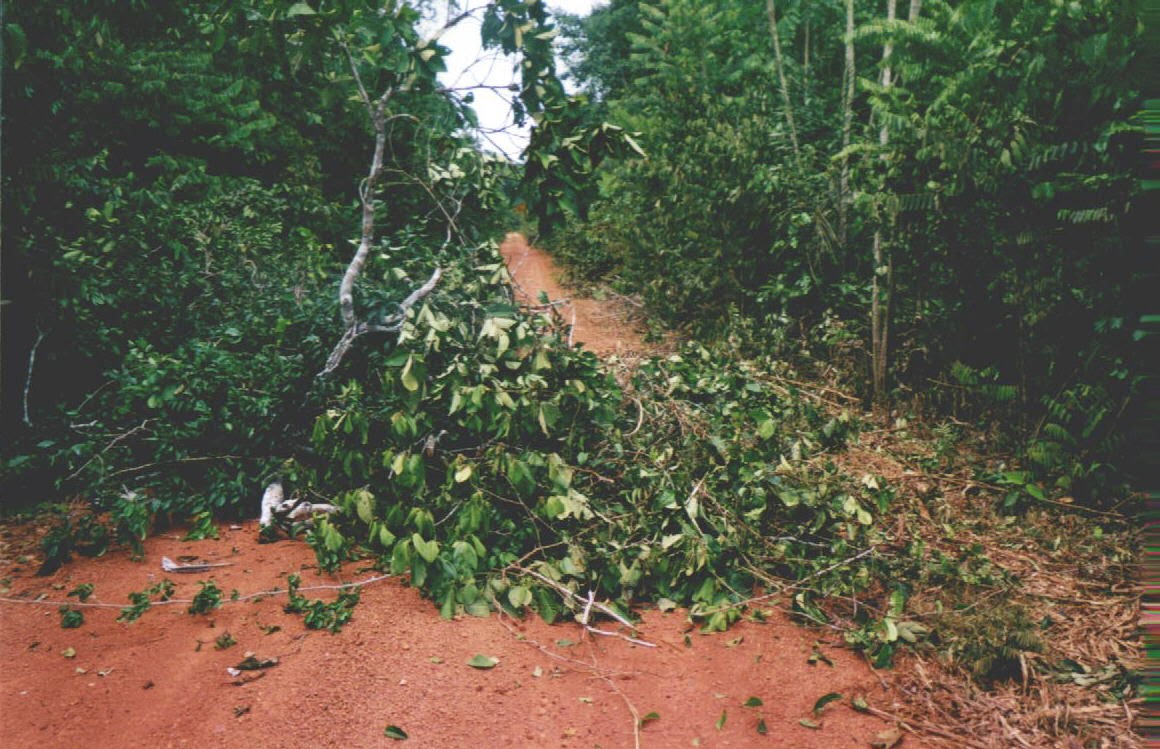
Besides for snakes and turtles I often have to stop to lift the bike over fallen trees. Some of them just felt recently, but someone already cleared the way and cars rolled over them. Only once the road is blocked by fresh greenery and I have to use my bushknife to cut my way. Thus and the steep hills make it difficult to proceed. I run out of water before I reach "Kilometro 180", and so I have to celebrate another tea ceremony to stock up my water supply.
I reach the village in the late afternoon. There are a couple of houses, one old, rusty car, and on the small square that usually seems to serve as the villages soccer field (even the smallest Brazilian village has it's own soccer field) there was a small airplane!! I wondered where it landed, I couldn't see a landing field. Soon I found out: while I was still wondering about the airfield and, especially which of the houses could be the local restaurant, another Cessna flew over me, honking it's horn until I noticed that I'm in the way: It actually landed on the highway, with less then 1 meter of space between each side of the wingtips and the trees.... A man hopped out, disappeared in one of the houses and the Cessna left as fast as it appeared...
There was no one in the bar except the waitress. She was not very communicative, so I couldn't find out how people earn their living there... Gold mining or service for the drug route from Peru to the Atlantic?? At least I learned that most of the supply comes in by air, that's why I paid prices 3 times higher than in less remote areas.
Two hours later it's time to find a place for the night again. Tonight I don't make the effort to camp in the jungle. I just set up the tent on the road, behind a fallen tree. There will be no traffic anyway...
Not a single car in two days. I worry about Marcus. He's probably still sitting on his backpack on the other side of the National park, waiting for a ride....
Nov. 5th
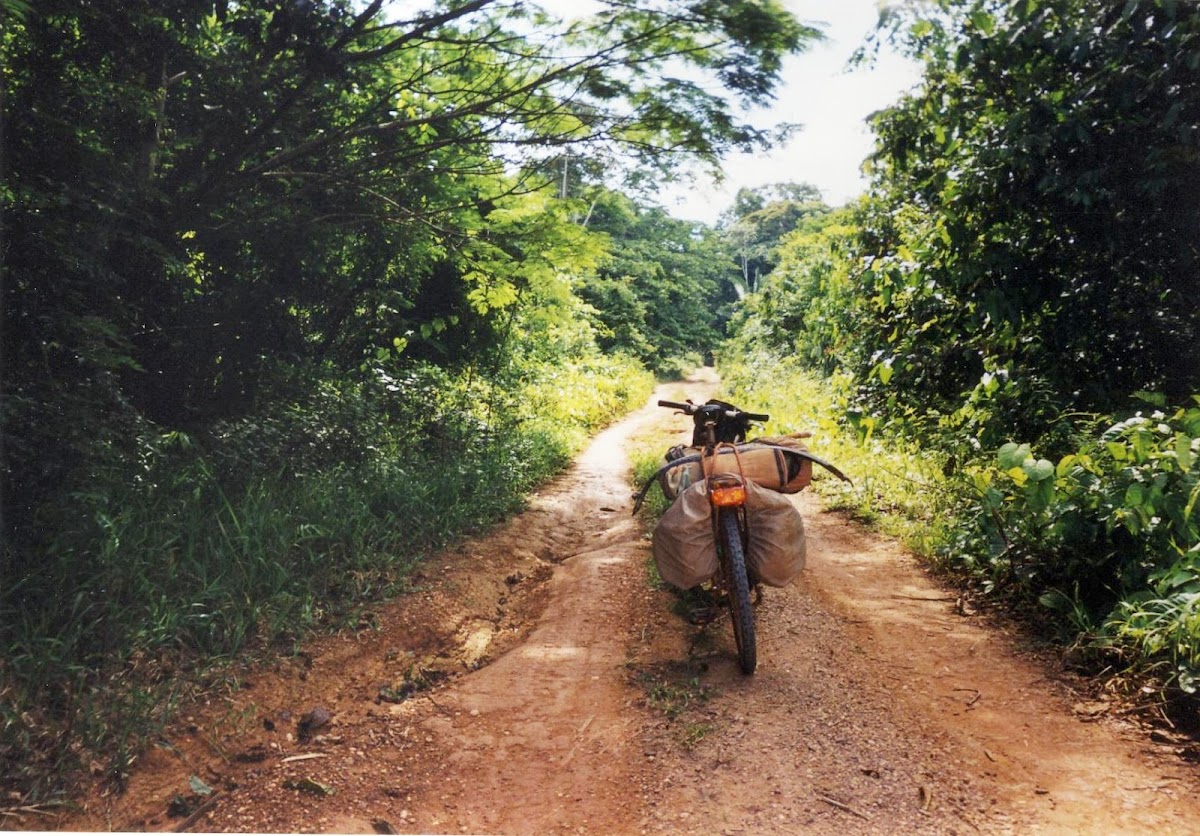
The road is terrible since I left "Kilometro 180". Probably I make more kilometers walking than cycling. The front deraileur doesn't work any more, so I have to stop each time I want to switch from small to medium gear to do it "manually". Besides that, the road is winding through the hills like crazy. At first I don't notice, I just wonder why I had the sun sometimes in my face and 10 minutes later on my back... Around noon it's impossible to guess the direction, the sun shines exactly from the top and gives you no clue. But a look at the compass confirms my impression that the architect of this road doesn't like me!!
I start to get bored. There is not much to see except the red-brown road and the greenery. No one to talk to and no place to buy a cold beer... Every cloud up at the sky makes me worry... if it starts raining here I might be trapped for a long time... I don't need to worry about food, I have enough supplies for more than a week, but it's an unknown feeling to be somewhere where it might take several days to reach the next outpost of the world as we know it...
But I seem to be lucky. As usual in the tropics several clouds pass by, but none of them actually hits me. These clouds cause very heavy showers, but they only affect a small stripe of land and usually pass by quickly.
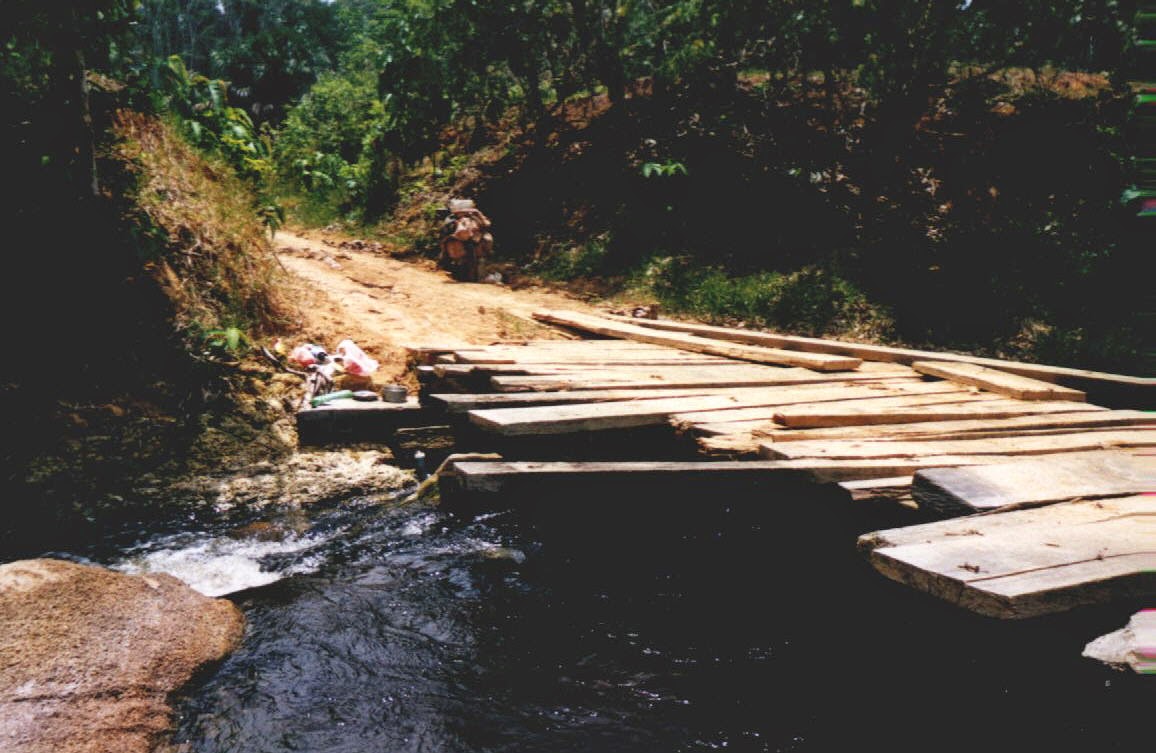
In the afternoon I prepared lunch, sitting on a big boulder in a river, a perfect place to avoid the annoying, omnipresent ants!!! I have a look at my arms and legs. There is not a single centimeter without scratches, mosquito punctures or ant bites and my right hand, which I burned in the sunshine almost 2 weeks ago, is evolving strange blisters.
The road continues much the same as before. Only late in the afternoon I pass a small clearing, with a small, open bamboo hut in the middle. There must be someone around, fresh washed clothes are hanging in front of the shack, and the oven is burning, but I can't see anyone. I wonder if I should stop here for the night, but then I decide to continue. The owner probably owns a gun and might be nervous when returning home and finding an unknown stranger on his land...
Nov 6th
I spent the night in the jungle. Humidity is so high that it starts raining from the trees every morning. I hope to reach Jacareacanga today, so I wake up before sunrise and pack my stuff in the "rain".
Crazy road. A make a comparatively good speed, much more than the usual 10 kilometers per hour, but its still zigzagging. By noon my GPS calculates a distance of only 30 kilometers to the starting point!!!

But I come closer to civilization. Once in a while I pass places similar to the clearing I saw yesterday. But it's always the same: I can see the smoke of the fire, but I never see any person. The "houses" are made only of bamboo and the roof is covered with palm leaves. I hope to meet someone to ask for directions. Jacareacanga is 10 or 15 kilometers of the road, and I don't want to miss the entrance...
While wondering about the people here and while enjoying a nice downhill I have to pass over several trees. They are already dry and flattened by several cars, so I see no reason to slow down. It should be no problem to pass over them at 25 or 30 km/h. No problem with the first one, no problem with the second one, no prob.... the front wheel kicks up an old branch, and that one lifts up a liana that slings around my right foot like an old rabbit trap. My foot is pulled down to the pedal, the whole bike is pushed to the right and I don't know how I manage to stop after the liana finally broke and released foot and pedal.... It takes some time until I can breath again. This will hurt for a long time!!
Finally I reach settled land, real farms and a junction that might be the one to Jacareacanga. I'm lucky once again, behind the next hill I can see someone on the roadside. It's actually the road to town, it's "not far", only 10 km or so, and "not very hilly". While I'm still talking with the man 3, 4 other people gather and they all ask me if I'm out "for the party" as well... Of course I didn't know about any party, but it seems to be a big event: there is even a party shuttle, an old Toyota pickup that runs up and down "main street" to pick up partygoers. No one asks if I would like a ride, they just lift my bike on top of the truck. I voluntarily accept, it saves me one and a half hours of dull riding into the wrong direction...tomorrow I have to cycle the same road backwards to get back to the Transamaz˘nica. Two or three more stops to pick up passengers, then I count: 16 persons, 5 chickens, one dog, 5 shotguns (one of them pointing into my direction), 10 backpacks, one bicycle, and, the most important, one bottle of cachaša. The driver blasts over the road at full speed, passengers are thrown fore and back and I wonder if it was really a good idea to "shortcut" this extra kilometers... 10 minutes later we reach the town and the empty bottle of cachaša is thrown onto the street.
Jacareacangas name is larger than the town itself. It's a town of maybe 1000 inhabitants, its center is about 2 blocks wide and one block long. But there is all you need: A restaurant, a hotel, a grocery store, pharmacy, post office and even a public telephone. It's the biggest town for the next 800 kilometers.

But before taking advantage of modern civilization I cycle a short distance out of town to reach the Tapajˇs beaches. The Rio Tapajˇs is one of the most beautiful rivers in Amazonia. It's water is very clean, there are big, white beaches, a lot of rapids and waterfalls and still a lot of nature. The rapids make it difficult to navigate. Big boats go only from Santarem (that's where the River meets the Amazon) to Itaituba. The other 1500 kilometers of the river are frequented only by small boats.
At night I have my bicycle welded (The eyelet for my lowrider), take a shower and off I go for the event of the year: A new restaurant opens in town, and that should be reason enough for a big party.
From here to Rio Madeira, the next big river, it's about 800 kilometers. I expect that stretch to be the most difficult part of my tour. On the map it looks very hilly, I have to cross a lot of smaller rivers and there are only few villages on the way. But locals tell me it would not be very hilly...
AtÚ logo
Micha
<-- continue part 5


